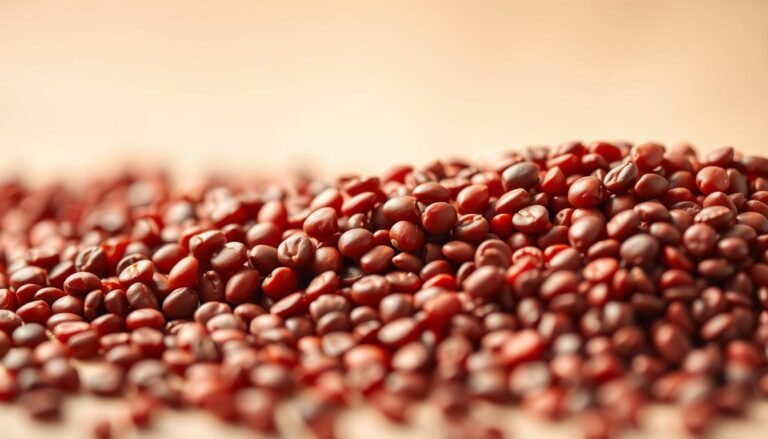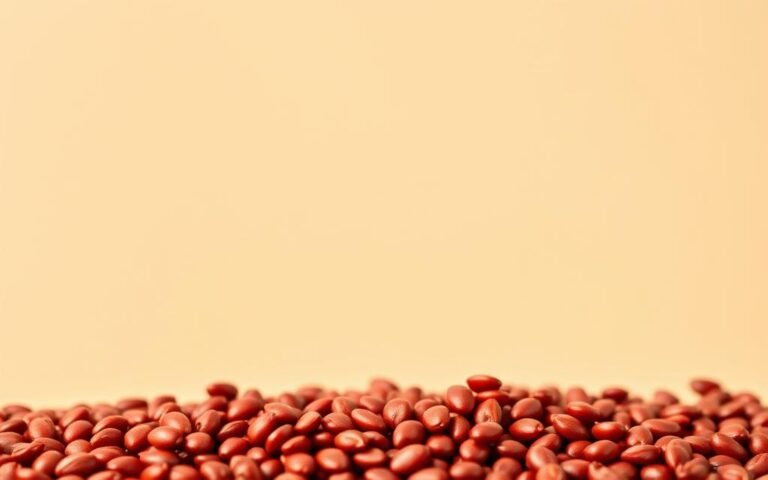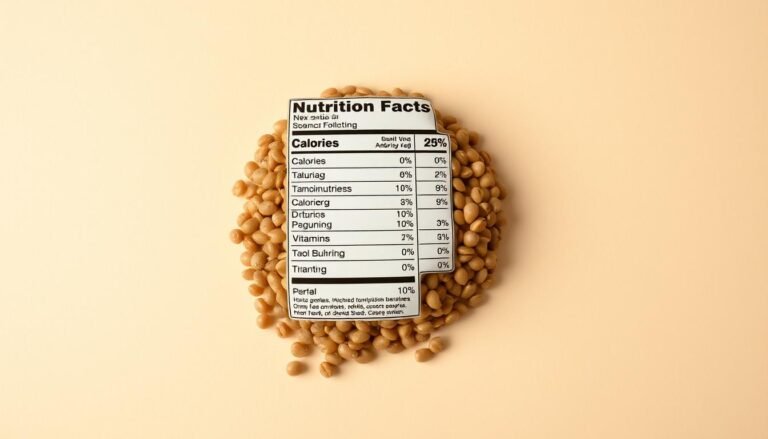Maintaining a healthy digestive system is crucial for overall well-being. One way to support digestion is by incorporating nutrient-rich foods into your diet. Red lentils are an excellent addition, being rich in fiber and protein.
These gut-friendly legumes have been a staple in many cuisines for centuries, providing essential nutrients and promoting digestive health. By including red lentils in your meals, you can reap their nutritional rewards and support a balanced digestive system.
Key Takeaways
- Red lentils are rich in fiber and protein.
- They support digestive health and promote a balanced gut.
- Incorporating red lentils into your diet can have numerous health benefits.
- Red lentils are a versatile and nutritious addition to meals.
- They are a great way to support overall digestive well-being.
What Are Red Lentils? Understanding This Nutritional Powerhouse
Red lentils are a nutritional powerhouse that has been a staple in many cuisines for centuries. They are an excellent source of fiber, protein, and various vitamins and minerals, making them a popular choice among health-conscious individuals.
Origin and Varieties of Red Lentils
Red lentils are one of the many varieties of lentils consumed globally. Originating from the Middle East and South Asia, they have been a crucial part of traditional diets for thousands of years. Red lentils are known for their bright orange-red color and are often used in soups, stews, and curries due to their ability to cook quickly and blend into the dishes.
There are several varieties of red lentils, including dehulled red lentils, which cook faster and are easier to digest. The diversity in red lentil varieties allows for a range of culinary applications, from hearty soups to flavorful dals.
Nutritional Profile at a Glance
Red lentils are rich in nutrients, offering a high content of dietary fiber, protein, and essential minerals like iron and potassium. They are also a good source of folate and various B vitamins. The nutritional profile of red lentils makes them an excellent addition to a balanced diet, supporting heart health, digestive health, and providing sustained energy.
According to nutritional experts, incorporating red lentils into one’s diet can have significant health benefits, including improved digestion and reduced risk of chronic diseases. As quoted by a renowned nutritionist, “Red lentils are a gut-friendly food that can play a significant role in maintaining a healthy digestive system.”
The Nutritional Composition of Red Lentils
Red lentils are a nutritional powerhouse that deserves attention for their numerous health benefits. They are an excellent source of essential nutrients that support overall well-being, particularly digestive health.
Protein Content and Quality
Red lentils are an excellent source of protein, making them an ideal choice for vegetarians and vegans. With approximately 26 grams of protein per 100 grams, they provide a significant amount of this essential macronutrient. The protein quality in red lentils is also noteworthy, as they contain essential amino acids that the body cannot produce on its own.
Essential Vitamins and Minerals
Red lentils are rich in various essential vitamins and minerals, including folate, iron, zinc, and potassium. Folate is particularly important for cell division and growth, while iron supports healthy red blood cells. Zinc plays a crucial role in immune function, and potassium helps regulate blood pressure.
Caloric Value and Macronutrient Balance
With a relatively low caloric value of approximately 350 calories per 100 grams, red lentils are a nutritious addition to a weight management diet. They also offer a balanced macronutrient profile, with a mix of protein, healthy carbohydrates, and minimal fat. This balance supports sustained energy and overall nutritional well-being.
Red Lentils Benefits for Digestion: The Complete Picture
The digestive benefits of red lentils are multifaceted, making them a valuable addition to a gut-friendly diet. Red lentils are rich in dietary fiber, which plays a crucial role in maintaining a healthy digestive system.
How Red Lentils Support Gut Health
Red lentils contain prebiotic fibers that feed the good bacteria in the gut, supporting a healthy gut microbiome. This prebiotic effect helps in promoting a balanced gut environment, which is essential for overall digestive health. A healthy gut microbiome is linked to various benefits, including improved nutrient absorption and a stronger immune system.
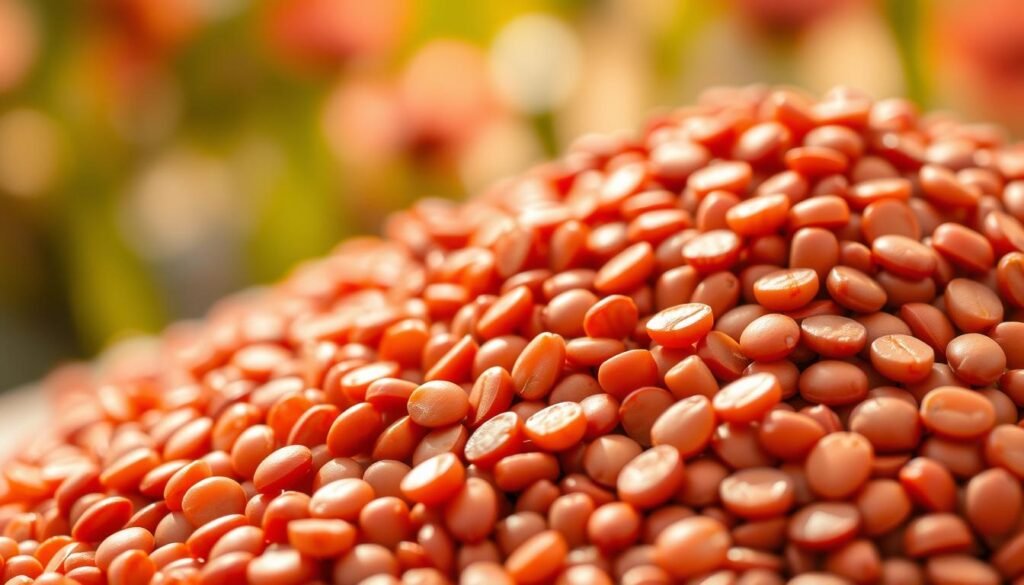
Digestive Enzymes and Red Lentils Interaction
The interaction between red lentils and digestive enzymes is another key aspect of their digestive benefits. Red lentils are a good source of complex carbohydrates, which are broken down by digestive enzymes into simpler sugars. This process not only aids in the absorption of nutrients but also helps in maintaining a healthy gut environment.
Furthermore, the fiber in red lentils can help slow down the digestion of carbohydrates, reducing the risk of sudden spikes in blood sugar levels. This makes red lentils an excellent choice for those looking to manage their blood sugar levels through dietary changes.
Incorporating red lentils into your diet can be a simple yet effective way to support your digestive health. With their rich nutritional profile and prebiotic properties, red lentils are an excellent addition to a balanced diet aimed at promoting overall well-being.
The Fiber Factor: Why Red Lentils Are Digestive Superheroes
Fiber-rich red lentils are considered digestive superheroes due to their ability to promote regular bowel movements and support a healthy gut. The significance of fiber in red lentils cannot be overstated, as it plays a crucial role in maintaining a well-functioning digestive system.
Soluble vs. Insoluble Fiber in Red Lentils
Red lentils contain both soluble and insoluble fiber, each contributing uniquely to digestive health. Soluble fiber dissolves in water to form a gel-like substance that helps slow down digestion, allowing for better nutrient absorption. On the other hand, insoluble fiber adds bulk to stool and aids in promoting regular bowel movements.
The combination of both types of fiber in red lentils makes them particularly effective at supporting gut health. Soluble fiber also acts as a prebiotic, feeding the good bacteria in the gut, which is essential for a healthy gut microbiome.
How Fiber Promotes Regular Bowel Movements
The insoluble fiber in red lentils helps to add bulk to the stool, making it easier to pass through the digestive system. This can be particularly beneficial for individuals suffering from constipation, as it helps to regulate bowel movements and prevent discomfort.
Furthermore, the fiber in red lentils helps to maintain a healthy gut environment by supporting the growth of beneficial gut bacteria. This can lead to a stronger immune system and overall better digestive health.
By incorporating fiber-rich red lentils into your diet, you can significantly support your digestive health and enjoy the benefits of regular bowel movements and a healthy gut.
Prebiotic Properties of Red Lentils
Red lentils are rich in prebiotic fibers, which play a crucial role in maintaining a healthy gut microbiome. These fibers serve as food for the beneficial bacteria in the gut, promoting a balanced digestive system.
Feeding Your Gut Microbiome
The prebiotic fibers in red lentils help to stimulate the growth of beneficial bacteria in the gut, enhancing the overall gut microbiome. This can lead to improved digestion and a stronger immune system. A healthy gut microbiome is essential for overall well-being, and consuming red lentils can be a simple yet effective way to support it.
Research on Prebiotics and Digestive Health
Research has shown that prebiotics, like those found in red lentils, can have a positive impact on digestive health. Studies have demonstrated that prebiotics can help to regulate bowel movements, reduce symptoms of irritable bowel syndrome, and even enhance the body’s immune response. By incorporating red lentils into your diet, you can harness these benefits and support a healthier digestive system.
Red Lentils and Their Role in Reducing Digestive Discomfort
Incorporating red lentils into your diet can be a game-changer for those suffering from digestive issues. Red lentils are rich in dietary fiber and nutrients that support gut health, potentially alleviating symptoms of digestive discomfort.
One of the primary ways red lentils contribute to digestive health is through their high fiber content. Fiber plays a crucial role in regulating bowel movements and preventing constipation. It also acts as a prebiotic, feeding the good bacteria in the gut, which is essential for a healthy gut microbiome.
Managing Bloating and Gas
Red lentils can help manage bloating and gas due to their fiber and raffinose content. Raffinose is a complex sugar that can be difficult for some people to digest, but it also feeds the beneficial bacteria in the gut, promoting a healthy gut environment. A well-balanced gut microbiome can reduce the occurrence of bloating and gas.
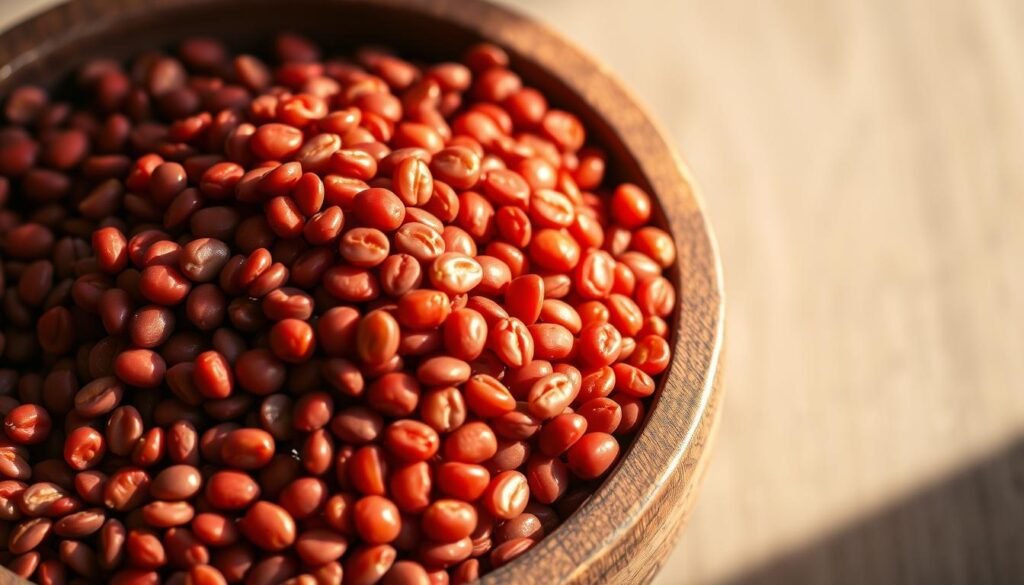
Soothing Irritable Bowel Symptoms
The fiber in red lentils can also help soothe symptoms of Irritable Bowel Syndrome (IBS). A diet rich in fiber can help regulate bowel movements and reduce the severity of IBS symptoms. Additionally, the anti-inflammatory properties of some compounds in red lentils may help reduce inflammation in the gut.
“A diet rich in fiber can significantly reduce the symptoms of IBS, improving the quality of life for those affected.”
Acid Reflux and Red Lentils
Red lentils may also play a role in managing acid reflux symptoms. Their high fiber content can help absorb excess stomach acid, potentially reducing the symptoms of acid reflux. Moreover, a diet rich in fiber can help maintain a healthy weight, which is also a factor in managing acid reflux.
| Benefit | Description |
|---|---|
| Managing Bloating and Gas | Red lentils help regulate gut bacteria, reducing bloating and gas. |
| Soothing Irritable Bowel Symptoms | Fiber in red lentils helps regulate bowel movements and reduce IBS symptoms. |
| Acid Reflux Management | High fiber content in red lentils can help absorb excess stomach acid. |
By incorporating red lentils into your diet, you can potentially alleviate digestive discomfort and support overall gut health. With their rich nutritional profile and digestive benefits, red lentils are an excellent addition to a healthy diet.
Weight Management Benefits Through Better Digestion
Incorporating red lentils into your diet can be a game-changer for weight management, thanks to their unique blend of fiber and protein. Red lentils are high in both soluble and insoluble fiber, making them very satiating and helpful for weight management. They also help regulate blood sugar levels, further supporting weight management efforts.
Satiety and Appetite Control
The high fiber and protein content in red lentils contribute significantly to feelings of fullness and satisfaction. “A diet rich in fiber and protein can lead to reduced hunger and calorie intake,” supporting weight management. By incorporating red lentils into meals, individuals can better control their appetite and reduce the likelihood of overeating.
Blood Sugar Regulation and Digestive Health
Red lentils have a low glycemic index, which means they are digested slowly, causing a gradual increase in blood sugar levels. This slow digestion helps in regulating blood sugar levels and preventing spikes in insulin levels, supporting overall digestive health and weight management. As a result, incorporating red lentils into one’s diet can be particularly beneficial for individuals with diabetes or those trying to manage their blood sugar levels.
By supporting both satiety and blood sugar regulation, red lentils provide a comprehensive approach to weight management through better digestion.
Comparing Red Lentils to Other Legumes for Digestive Health
Understanding how red lentils stack up against other legumes in terms of digestion is essential for making informed dietary choices. Legumes are a diverse group of plants that include lentils, beans, and peas, all of which are known for their nutritional benefits. However, their impact on digestive health can vary significantly.
Red vs. Green Lentils: Digestive Impact
Red lentils and green lentils share many nutritional similarities, but they differ in their digestive impact. Red lentils are generally considered easier to digest due to their lower fiber content compared to green lentils. Red lentils break down more quickly during cooking, making their nutrients more accessible to the body. This can be particularly beneficial for individuals with sensitive digestive systems.
Lentils vs. Beans: Ease of Digestion
When comparing lentils to beans, lentils are often considered the more digestive-friendly option. This is largely due to their lower FODMAP content. Beans contain complex sugars that can be difficult for some people to digest, leading to discomfort. In contrast, lentils, including red lentils, are generally lower in these problematic compounds, making them a better choice for those prone to digestive issues.
Why Red Lentils May Be Gentler on Your Gut
Red lentils are often considered gentler on the gut compared to other legumes due to their lower FODMAP content and higher digestibility. They are rich in fiber, which supports healthy gut bacteria. The table below summarizes the key differences between red lentils and other legumes in terms of digestive health.
| Legume Type | FODMAP Content | Fiber Content | Digestive Ease |
|---|---|---|---|
| Red Lentils | Low | High | Easy |
| Green Lentils | Moderate | Higher | Moderate |
| Beans | High | High | Difficult |
In conclusion, red lentils offer a compelling option for those seeking to support their digestive health through diet. Their unique combination of low FODMAPs and high fiber makes them an attractive choice for individuals looking to incorporate more legumes into their meals without compromising digestive comfort.
Preparing Red Lentils for Optimal Digestion
Preparing red lentils correctly can significantly improve their digestibility and nutritional value. Red lentils are a versatile ingredient, but their digestibility can be enhanced with the right preparation methods.
Soaking Methods to Reduce Anti-Nutrients
Soaking red lentils is a simple yet effective way to reduce anti-nutrients and improve digestibility. Soaking for at least 30 minutes can help break down some of the complex compounds that may cause digestive discomfort. It’s recommended to soak them in water, and you can also add a tablespoon of lemon juice or vinegar to enhance the process.
Cooking Techniques That Enhance Digestibility
Cooking red lentils is crucial for making them easily digestible. Boiling or steaming are effective methods, but it’s essential to cook them until they’re tender. Overcooking can lead to a loss of nutrients, so it’s a balance between cooking enough to enhance digestibility without losing the nutritional value.
Sprouting Red Lentils for Digestive Benefits
Sprouting red lentils can further enhance their digestibility and nutritional profile. Sprouting activates enzymes that break down some of the anti-nutrients, making the lentils easier to digest. To sprout, soak the lentils overnight, then drain and rinse them, leaving them in a jar or sprouting container until they sprout.
Using Pressure Cookers for Better Digestibility
Using a pressure cooker is another effective method for cooking red lentils, significantly reducing cooking time and enhancing digestibility. Pressure cooking can break down the cell walls more efficiently than traditional boiling, making the lentils easier on the digestive system.
Common Digestive Issues and How Red Lentils Can Help
For those struggling with digestive issues, incorporating red lentils into their diet can be a game-changer. Red lentils are rich in fiber and contain anti-inflammatory properties that can help alleviate common digestive problems.
Digestive health is crucial for overall well-being, and red lentils offer a natural solution to support gut health. The high fiber content in red lentils can help regulate bowel movements, reduce inflammation, and promote a healthy gut microbiome.
Constipation Relief with Red Lentils
Red lentils are an excellent source of dietary fiber, which is essential for preventing constipation. The soluble fiber in red lentils helps soften stool and promote regular bowel movements. Incorporating red lentils into your diet can help reduce the risk of constipation and support a healthy digestive system.
Managing Diarrhea Through Fiber Regulation
While it may seem counterintuitive, red lentils can also help manage diarrhea due to their fiber content. The soluble fiber helps regulate bowel movements and firm up stool, reducing the incidence of diarrhea. Additionally, the prebiotic properties of red lentils support the growth of beneficial gut bacteria, further aiding in diarrhea management.
Red Lentils and Gut Inflammation
Red lentils contain anti-inflammatory compounds that can help reduce gut inflammation. Chronic inflammation in the gut can lead to various digestive issues, including irritable bowel syndrome (IBS). The anti-inflammatory properties of red lentils can help soothe the gut lining and reduce inflammation, promoting a healthier digestive system.
| Digestive Issue | How Red Lentils Help |
|---|---|
| Constipation | High fiber content softens stool and promotes regular bowel movements |
| Diarrhea | Fiber regulation helps firm up stool and reduce incidence |
| Gut Inflammation | Anti-inflammatory compounds reduce inflammation and soothe gut lining |
Potential Digestive Challenges with Red Lentils
Red lentils are generally considered easy to digest, but some people may still experience digestive challenges. While they offer numerous red lentils benefits for overall health, individuals with sensitive digestive systems or those who are not accustomed to consuming high FODMAP foods may need to take precautions.
Understanding FODMAPs in Red Lentils
Red lentils contain FODMAPs (Fermentable Oligo-, Di-, Mono-saccharides, and Polyols), which can be problematic for some individuals. FODMAPs are types of carbohydrates that can cause bloating, gas, and discomfort in people with irritable bowel syndrome (IBS) or those with FODMAP intolerance. The FODMAP content in red lentils can be a concern, particularly for those who are not used to eating foods high in these compounds.
Tips for Sensitive Digestive Systems
For individuals with sensitive digestive systems, there are ways to minimize potential discomfort while still enjoying the digestion support offered by red lentils. Start by consuming small portions to gauge your tolerance. You can also try soaking or sprouting red lentils, which may reduce their FODMAP content. Additionally, cooking red lentils thoroughly can make them easier to digest. If you experience persistent discomfort, consider consulting a healthcare professional or a registered dietitian for personalized advice.
Red Lentil Recipes That Support Digestive Health
With their high fiber content and ease of preparation, red lentils are an ideal ingredient for supporting digestive health. Incorporating these fiber-rich lentils into your meals can significantly enhance your gut health.
Easy Red Lentil Soup for Gut Health
A simple and nourishing option is a red lentil soup made with vegetables and digestive spices. This dish is not only comforting but also packed with nutrients that support digestion. To prepare, sauté onions, garlic, and ginger, then add red lentils, broth, and your choice of vegetables, simmering until the lentils are tender.
Red Lentil Dahl with Digestive Spices
Red lentil dahl is a popular dish in many cuisines, known for its digestive benefits. By incorporating spices like cumin, coriander, and turmeric, you can enhance the digestion support properties of this meal. Cook red lentils with these spices and serve over rice or with naan bread for a satisfying meal.
Australian-Inspired Red Lentil Dishes
Australia’s multicultural cuisine offers a wide range of inspiration for red lentil recipes. From hearty lentil stews to innovative salads, there’s no shortage of ways to enjoy fiber-rich lentils. Consider a red lentil and vegetable stew with a side of whole grain bread for a filling meal.
Incorporating Red Lentils into Your Weekly Meal Plan
To make the most of red lentils’ digestive benefits, try to include them in your meal plan at least twice a week. They can be added to soups, stews, curries, and salads, providing a boost of fiber and protein. Experiment with different recipes to keep your meals interesting and ensure you’re getting the digestion support you need.
Australian Dietary Guidelines and Red Lentils
Red lentils are a nutritious addition to meals, aligning with Australian nutrition recommendations that promote legume consumption. The Australian dietary guidelines emphasize the importance of legumes in a healthy diet, and red lentils are an excellent choice due to their high nutritional value.
How Red Lentils Fit into Australian Nutrition Recommendations
Red lentils are rich in protein, fiber, and essential nutrients, making them a great fit for the Australian dietary guidelines. These guidelines recommend increasing the consumption of legumes, which includes lentils, to improve overall health and reduce the risk of chronic diseases. For more information on enhancing nutrition with pulses, you can refer to resources like this document on pulse nutrition.
Local Australian Sources for Quality Red Lentils
Australia has several local suppliers of high-quality red lentils. Consumers can find red lentils in most health food stores and supermarkets. It’s recommended to choose lentils that are sourced from reputable suppliers to ensure quality and nutritional value. Supporting local farmers not only ensures freshness but also contributes to the local economy.
By incorporating red lentils into your diet, you are not only supporting your digestive health but also aligning with the Australian dietary guidelines. With their numerous health benefits and local availability, red lentils are a great addition to any meal.
Scientific Research on Red Lentils and Digestive Health
The scientific community has been exploring the potential of red lentils to support digestive health, with promising results. Research has shown that red lentils can improve digestive health by regulating the gut microbiome and reducing inflammation.
Recent Studies and Clinical Findings
Recent studies have investigated the effects of red lentils on gut health. A key finding is that red lentils are rich in dietary fiber, which plays a crucial role in promoting regular bowel movements and supporting the growth of beneficial gut bacteria. Clinical trials have also demonstrated that consuming red lentils can lead to a reduction in symptoms of digestive discomfort, such as bloating and gas.
What Australian Nutritionists Say About Red Lentils
Australian nutritionists recommend red lentils as a nutritious addition to the diet, citing their high fiber and protein content. According to experts, incorporating red lentils into one’s diet can have a positive impact on overall digestive health. Many Australian health professionals suggest that red lentils can be a valuable component of a balanced diet, particularly for individuals looking to manage digestive issues.
Future Research Directions
While current research has provided valuable insights into the benefits of red lentils for digestive health, further studies are needed to fully understand their potential. Future research directions may include investigating the specific compounds in red lentils responsible for their digestive benefits, as well as exploring their potential therapeutic applications. As our understanding of the relationship between diet and gut health continues to evolve, red lentils are likely to remain a key area of interest.
Conclusion: Making Red Lentils a Regular Part of Your Digestive Health Routine
Incorporating red lentils into your diet can have significant red lentils benefits for digestive health. As discussed, these versatile and nutritious legumes support a healthy digestive system through their high fiber content, prebiotic properties, and ease of digestion.
To experience the digestion support that red lentils offer, try adding them to your meals. They can be easily incorporated into soups, stews, curries, and salads, making them a great addition to a variety of cuisines.
By making red lentils a regular part of your diet, you can promote a balanced gut microbiome, reduce digestive discomfort, and support overall digestive well-being. With their nutritional profile and ease of preparation, red lentils are an excellent choice for those seeking to improve their digestive health.
Start enjoying the benefits of red lentils today and take the first step towards a healthier digestive system.


